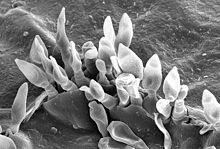Dothideomycetes
| Dothideomycetes | |
|---|---|
 |
|
| The reproductive conidia of Venturia inaequalis erupting through the cuticle of a crabapple leaf | |
| Scientific classification | |
| Kingdom: | Fungi |
| Division: | Ascomycota |
| Subdivision: | Pezizomycotina |
| Class: | Dothideomycetes |
| Subclasses & Orders | |
|
Incertae sedis |
|
Incertae sedis
Dothideomycetes is the largest and most diverse class of ascomycete fungi. It comprises 11 orders 90 families, 1300 genera and over 19,000 known species. Traditionally, most of its members were included in the loculoascomycetes, which is not part of the currently accepted classification. This indicates that several traditional morphological features in the class are not unique and DNA sequence comparisons are important to define the class.
The designation loculoascomycetes was first proposed for all fungi which have ascolocular development. This type of development refers to the way in which the sexual structure, bearing the sexual spores (ascospores) forms. Dothideomycetes mostly produce flask-like structures referred to as pseudothecia, although other shape variations do exist (e.g. see structures found in Hysteriales). During ascolocular development pockets (locules) form first within the vegetative cells of the fungus and then all the subsequent structures form. These include the asci which, superficially, have a thicker outer layer through which a thinner inner layer ‘bursts’, like a jack-in-a-box to release the spores. These asci are therefore referred to as bitunicate (superficially, two layers) or fissitunicate (referring to spore release). After several DNA sequence comparisons it is now clear that another group of fungi which share these characteristics are distantly related. These are the "black yeasts" in subclass Chaetothyriomycetidae (Eurotiomycetes). This means that loculoascomycetes did not constitute a natural group.
...
Wikipedia
